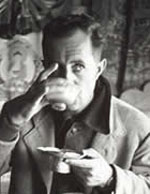Giuseppe Tucci

Giuseppe Tucci (5 June 1894 – 5 April 1984), was an Italian scholar of oriental cultures, specialising in Tibet and history of Buddhism. He was fluent in several European languages, Sanskrit, Bengali, Pali, Prakrit, Chinese and Tibetan and he taught at the University of Rome La Sapienza until his death. He is considered one of the founders of the field of Buddhist Studies.
Life and work
Education and background
He was born to a middle-class family in Macerata, Marche, and thrived academically. He taught himself Hebrew, Chinese and Sanskrit before even going to university and in 1911, aged only 18, he published a collection of Latin epigraphs in the prestigious Review of the Germanic Archaeological Institute. He completed his studies at the University of Rome in 1919, where his studies were repeatedly interrupted as a result of World War I.
After graduating, he traveled to India and settled down at the Visva-Bharati University, founded by the Bengali poet and Nobel Laureate, Rabindranath Tagore. There he studied Buddhism, Tibetan and Bengali, and also taught Italian and Chinese. He also studied and taught at Dhaka University, the University of Benares and Calcutta University. He remained in India until 1931, when he returned to Italy.
Scholarship and reputation
He was Italy's foremost scholar of the East, with such diverse research interests ranging from ancient Iranian religion to Chinese philosophy. He taught primarily at the University of Rome but was a visiting scholar at institutions throughout Europe and Asia. In 1931, the University of Naples made him its first Chair of Chinese Language and Literature. In 1933, with the philosopher Giovanni Gentile, he founded the Italian Institute for the Middle and Far East (Istituto italiano per il Medio ed Estremo Oriente), based in Rome. He organised several pioneering archaeological digs throughout Asia, such as in Swat in Pakistan, Ghazni in Afghanistan, Persepolis in Iran and in the Himalayas. He was also the promoter of the National Museum of Oriental Art. In 1978 he received the Jawaharlal Nehru Award for international understanding, in 1979 the Balzan Prize for History (ex aequo with Ernest Labrousse). During the course of his life, he wrote over 360 books and articles.
Tucci died in San Polo dei Cavalieri, near Rome, in 1984.
Selected bibliography
- Indo-tibetica 1: Mc'od rten e ts'a ts'a nel Tibet indiano ed occidentale: contributo allo studio dell'arte religiosa tibetana e del suo significato, Roma, Reale Accademia d'Italia, 1932;
- Indo-tibetica 2: Rin c'en bzan po e la rinascita del buddhismo nel Tibet intorno al Mille, Roma, Reale Accademia d'Italia, 1933 (English transl.: Rin-chen-bzan-po and the renaissance of Buddhism in Tibet around the millennium, New Delhi, Aditya Prakashan, [1988]);
- (with E. Ghersi) Cronaca della missione scientifica Tucci nel Tibet occidentale (1933), Roma, Reale Accademia d'Italia, 1934 (English transl.: Secrets of Tibet. Being the chronicle of the Tucci Scientific Expedition to Western Tibet, 1933, London & Glasgow, Blackie & Son, 1935);
- Indo-tibetica 3 : I templi del Tibet occidentale e il loro simbolismo artistico, 2 vols, Roma, Reale Accademia d'Italia, 1935-1936;
- Santi e briganti nel Tibet ignoto: diario della spedizione nel Tibet occidentale 1935, Milano, U. Hoepli, 1937;
- Indo-tibetica 4: Gyantse ed i suoi monasteri, 3 vols, Roma, Reale Accademia d'Italia, 1941 (English transl.: Gyantse and its monasteries, New Delhi, Aditya Prakashan, 1989);
- Asia religiosa, Roma, Partenia, 1946;
- Tibetan Painted Scrolls, 3 vols, Roma, Istituto Poligrafico e Zecca dello Stato, 1949;
- Teoria e pratica del Mandala, Roma, Astrolabio, 1949 (English transl.: The theory and practice of the Mandala, London, Rider and Co., 1961);
- Italia e Oriente, Milano, Garzanti, 1949;
- Tibetan folksongs from the district of Gyantse, Ascona, Artibus Asiae, 1949; 2nd rev. ed. 1966;
- The Tombs of the Tibetan Kings, Roma, IsMEO, 1950;
- A Lhasa e oltre, Roma, La Libreria dello Stato, 1950 (English transl.: To Lhasa and beyond, Roma, La Libreria dello Stato, 1956);
- Tra giungle e pagode, Roma, La Libreria dello Stato, 1953;
- Preliminary report on two scientific expeditions in Nepal, Roma, IsMEO, 1956;
- Storia della filosofia indiana, Bari, Laterza, 1957;
- Nepal: alla scoperta dei Malla, Bari, Leonardo da Vinci, 1960 (English transl.: Nepal. The discovery of the Malla, London, George Allen & Unwin, 1962);
- Die Religionen Tibets in G. Tucci and W. Heissig, Die Religionen Tibets und der Mongolei, Stuttgart, W. Kohlhammer, 1970 (English transl.: The religions of Tibet, London, Routledge & Kegan Paul, 1980).
References
- Giuseppe Tucci: Commemorazione tenuta dal Presidente dell'Istituto Gherardo Gnoli il 7 maggio 1984 a Palazzo Brancaccio, Roma, IsMEO, 1984;
- Raniero Gnoli, Ricordo di Giuseppe Tucci, Roma, IsMEO, 1985;
- Giuseppe Tucci nel centenario della nascita : Roma, 7-8 giugno 1994, a cura di Beniamino Melasecchi, Roma, IsMEO, 1995;
- Giuseppe Tucci : Un maceratese nelle terre sacre dell'Oriente, Macerata, Comune di Macerata, 2000;
- Tucci l'esploratore dell'anima, Catalogue of the Exhibition, Pollenza, Arte Nomade, 2004 (in Italian and English)
- Enrica Garzilli, "Un grande maceratese che andò lontano: Giuseppe Tucci, le Marche e l'Oriente" [English and Italian], in Identità Sibillina, Anno 2006, n. 2.
Footnotes
External links
- Giuseppe Tucci: Life, Travels and Adventures of the Explorer of Fascism (including unedited documents) : Blog
- Giuseppe Tucci: Life and Works, Explorations, Digital library, Photographic archives, Texts' collections
- A Great Man from Macerata Who Went Far: Giuseppe Tucci - the Marches Region and the East
- Images of Earth and Water: The Tsa-Tsa Votive Tablets of Tibet - Giuseppe Tucci and Stupa Symbolism
